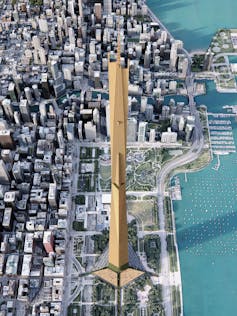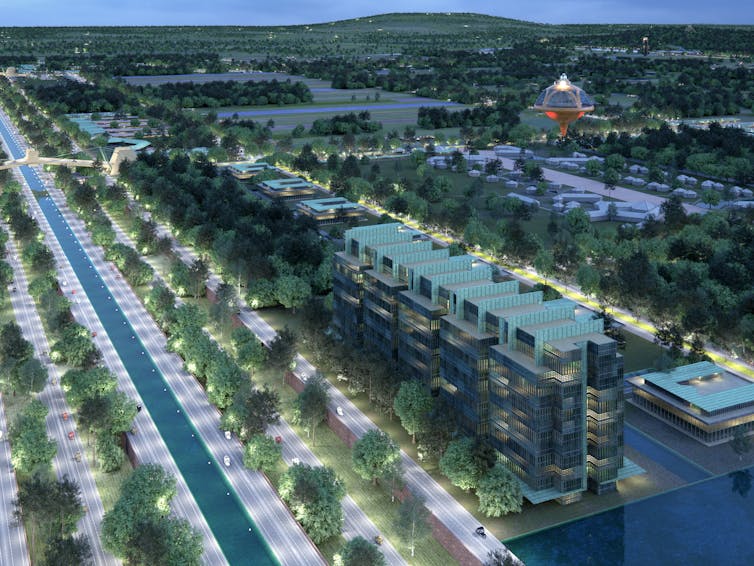Spanish architect David Romero recently released a series of digital visualisations of unbuilt architectural projects by one of the 20th century’s most eminent American architects, Frank Lloyd Wright. His fascinating 3D renderings underscore the potential of this technology and tell us a great deal about the breadth and ambition of Wright’s vision more than six decades after his death.
As a researcher, I am captivated by unbuilt architecture, having worked alongside the site of Sir Edwin Lutyens’ largely unbuilt Metropolitan Cathedral design in Liverpool for many years. To unpack this topic, we first need to understand why unbuilt architecture “exists” at all.
Given the sheer size of buildings, architects rely on scaled drawings and models to develop ideas. These can either be hand-produced on paper, or via computer software where designs are usually drawn at a 1:1 scale and viewed on a digital screen as a scaled-down version.
Designing a building can take weeks, months or even years. And in countless cases they never make it off the drawing board at all, remaining unbuilt despite the will of all involved.
Unintentionally unbuilt
The fact that such designs are not built is therefore unintentional. American art historian George R. Collins suggests the reasons include unsuccessful competition entries, unfeasible costs and complexities, or frustrations such as changes to the project team and resistance within the community or planning department.
Consider the opposite fates of Lutyens’ Metropolitan Cathedral in Liverpool and Antoni Gaudí’s Sagrada Família church in Barcelona. Construction began on the former in 1933, partly propelled by a strong relationship between the archbishop and architect.
But in the years following the second world war both had died and funding was scarce, and only the crypt was completed. This left a partially (un)built scheme which was capped with a new design by Sir Frederick Gibberd. Lutyens’ design is remembered through surviving drawings, models, artefacts and the built crypt itself.
The Sagrada Família church, taken on by Gaudí in the 1880s, could have suffered a similar fate, with progress also hindered by war and the accidental death of the architect in 1926. But the church had already been under construction for more than 40 years when Gaudí died, and work to complete the building continues to this day.
Although highly unlikely, perhaps one day Lutyens’ design will be built. Ludwig Mies van der Rohe’s renowned German Pavilion, which he designed with his close collaborator Lily Reich, was intended as a temporary building for the 1929 International Exposition in Barcelona and demolished the following year. Yet it was rebuilt in the city in 1986, leaving some wondering whether the reconstruction was authentic or a fake. While it may look almost identical to the original after carefully following the 1929 design, the new version will always be a replica.
Intentionally unbuilt
This debate tends to assume that all designs are intended to be built. But what if some buildings were never intended to be built at all? Why bother designing them in the first place? In the richly imagined worlds of gaming, film and television, huge resources are invested in creating detailed fantasy cities, such as the ‘God of War‘ computer game series, films like Peter Jackson’s Lord of the Rings trilogy or TV dramas such as Game of Thrones.

The design of Frank Lloyd Wright’s 1950s skyscraper Illinois is echoed by Dubai’s Burj Khalifa. David Romero. Courtesy of Frank Lloyd Wright Foundation, Author provided
But sometimes buildings are designed as a way to create prototypes and visionary schemes for the future – architects allowing their creativity to be unbounded by the concerns and confines of the real world, such as space or cost or limited technology.
It is this category that the majority of Wright’s unbuilt projects fall into, as rendered by David Romero. Did Wright really believe his mile-high skyscraper design would be taken seriously in the 1950s? Perhaps not, but the world’s current tallest building, the Burj Khalifa completed in Dubai in 2009, bears a striking resemblance to Wright’s design, demonstrating how visionary ideas can influence future buildings.
The power of visualisations
The introduction of widespread 3D digital modelling software in the 1990s resulted in a renewed interest in unbuilt architecture, given the newfound technological capability to recreate them.
Perhaps more useful still was the ability to “rebuild” destroyed monuments, buildings and sites. Such visualisations raise many questions however. For example, how can we be certain that the digital rendering is what the building would actually have looked like? And is there enough evidence to faithfully reproduce it?
Romero recognises the challenge of incomplete information in his interview with the Frank Lloyd Wright Foundation’s architectural historian Jennifer Gray. He describes how Wright’s design for Broadacre City, a visionary scheme for American suburban living in the 1930s, offered little in the way of detailed architectural drawings. Romero therefore filled in many gaps in his digital model by looking at Wright’s other unbuilt works, where detailed drawings did exist.

Broadacre City – Frank Lloyd Wright’s ambitious design remained unrealised. David Romero, Author provided
Such acknowledgements are essential, as set down in the 2009 London Charter for computer-based visualisation of cultural heritage. This provides a set of principles to ensure technical and intellectual rigour for those creating visualisations of unbuilt or destroyed designs.
A key aspect here, like a maths exam, is to show your working out. Realistic-looking computer renders can be suggestive of truth, so sharing the level of confidence in the source data used to create them ensures that viewers fully understand what they are looking at – and the process that put it together.
Architect, lecturer and writer Rob Wilson neatly summarises the fascination with unbuilt architecture in his essay ‘Fighting the Banalities of the Built’:
The built environment we inhabit is just the residue of a much greater imaginative world that never saw the light of day, evoking what might have been or still could be – the unbuilt, the lost.
Nick Webb, Senior Lecturer in Architecture, University of Liverpool
This article is republished from The Conversation under a Creative Commons license. Read the original article.

